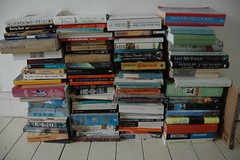
Image via VatorNews
When Amazon launched Kindle Owners’ Lending Library, their free e-book lending library back in November it was a concept, a gamble, a challenge.
Amazon unveiled a long-rumored “Netflix-for-books” digital lending library Wednesday. Via yet another enhancement for Amazon Prime, subscribers who also own Kindles can borrow one (and only one) book per month from about 5,000 available titles. (Wired.com)
Less than three months later it’s taken off, and its potential is just beginning to take shape.
According to the company, customers borrowed nearly 300,000 (295,000 to be exact) KDP Select titles in December alone, and KDP Select has helped grow the total library selection. With the $500,000 December fund, KDP authors have earned $1.70 per borrow. In response to strong customer adoption of the Kindle Owners’ Lending Library, Amazon says it has added a $200,000 bonus to the January KDP Select fund, raising the total pool from $500,000 to $700,000 for authors. (TechCrunch)
Who knew libraries would profit indie authors in the digital age? Another encouraging indicator for storytelling buskers… Sure Amazon’s free e-books (like their free videos) are incentives to sell Kindles and Amazon Prime, but the numbers are encouraging at a time when writers are gushing content virtually uncompensated.
Am I gushing? Yes. Am I habitually, unabashedly pollyanna-ish? Yes! But I can’t help getting excited (and optimistic) about what this means for indie authors. I understand that Amazon’s motives are market dominance and an eventual payday, but there’s a fascinating shift afoot, and from the vantage of a latter day storyteller, it opens up exciting new opportunities fellow narrative crafters. KDP Select is starting to look a lot more inviting, right?
Amazon this morning announced that it has set up a $6 million annual fund dedicated to independent authors and publishers. Dubbed KDP Select, the fund aims to let indie authors and publishers “make money in a whole new way”… [When] a KDP author or publisher chooses to make any of their books exclusive to the Kindle Store for at least 90 days, those books are eligible to be included in the Kindle Owners’ Lending Library and can earn a share of the KDP Select fund. (TechCrunch)
Of course, not everyone’s happy, and I suspect that it may be a couple of years before we can accurately evaluate the impact this will have on traditional publishers and authors. Plenty of cynics and skeptics are offering doomsday prophecies, but this warning in particular gives me pause, reminding me not to leap before I know how high the tide.
The Author’s Guild attacked Amazon after the Kindle Lending Library was announced, claiming that the program (in which Amazon actually purchases a copy of the book at cost to itself) “appears to be boldly breaching its contracts with these publishers. This is an exercise of brute economic power.” (HotHardware)
Brute economic power for sure, and risks abound, but at this early way station it looks like at least some authors are profiting.
Rachel Yu, a 16 year-old high school student, earned $6,200 in December from e-books she wrote and published via a related Amazon initiative called KDP Select… her children’s books, including titles such as “The Magical Dragon’s Three Gifts,” were among the most borrowed through the Kindle Owners’ Lending Library. (MediaFile)
Although this prodigy is still too young to enroll directly in the program, her parents fronted her success, suggesting that the KDP Select must be family-friendly and tolerant of round pegs in square holes. Not necessarily a common description for traditional publishing…
Carolyn McCray, a writer of paranormal romance novels, historical thrillers and mysteries, earned $8,250 from the KDP Select fund in December. “KDP Select truly is a career altering program,” said McCray. “I couldn’t be happier with the tools, support and exposure it has given me. To say the trade-off of exclusivity on Amazon for the Kindle Owners’ Lending Library has been a profitable one would be a gross understatement. Participating in KDP Select has quadrupled my royalties.” (TechJournal South)
Amber Scott is a romance writer and earned $7,650 from the KDP Select fund in December. “Enrolling in KDP Select utterly transformed my career,” said Scott. “I’ve experienced not only a surge in royalties but a surge in readership thanks to the increased exposure. I love the chance to earn new readers through the innovation of the Kindle Owners’ Lending Library. What an exciting time to be an author.” (TechJournal South)
Three inspiring stories don’t define a rule, but the picture is promising. Where from here? I suspect the numbers from January will be exciting too, especially considering how many Kindles allegedly sold in the holiday fervor. Vice President of Kindle Content, Russ Grandinetti, touched on the proven marketing potential of offering free e-books through the Kindle library.
“We knew customers would love having KDP Select titles in the Kindle Owners’ Lending Library. But we’ve been surprised by how much paid sales of those same titles increased, even relative to the rest of KDP.” (eBookNewser)
Perhaps the digital age will see a return to busking and libraries. I hope so. And our first glimpse of Kindle Owners’ Lending Library invites optimism.
Like this:
Like Loading...













